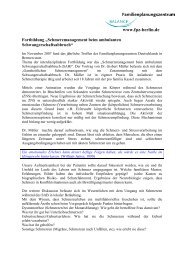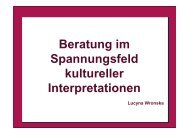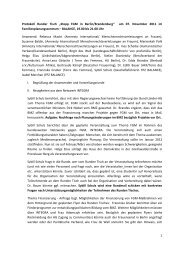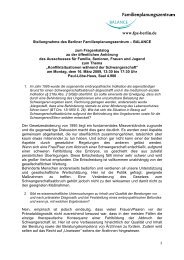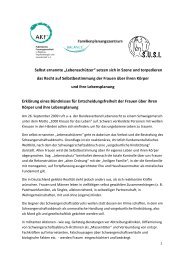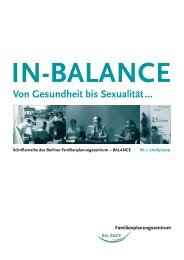sions questioning the practice and encouraging attitudechanges. Furthermore, immigrants belonging <strong>to</strong> thesepopulations need <strong>to</strong> be informed about FGM/C in casethat they marry in<strong>to</strong> a practicing family.The table below provides important indications on how<strong>to</strong> direct awareness-raising activities. The second columngives an approximate estimate of the <strong>to</strong>tal number of immigrantsliving in Hamburg from a particular community.The estimates are founded on impressions gathered duringthe research and might, thus, be inadequate. The followingcountries are not included in the typology due <strong>to</strong> insufficientdata: Eritrea, Sudan, Senegal, Liberia, Guinea Bissauand Sierra Leone. We recommend that more information becollected on the immigrant populations from these countries.The data from Burkina Faso and Benin might also need <strong>to</strong> becompleted with more interviews.Apart from the typologies, the following paragraphs outlinea brief summary of the findings for the various immigrantcommunities from Sub-Saharan Africa by country of origin.6.6.2. GhanaThe Ghanaian immigrant population affected by FGM/C isvery small. Except for a handful of supporters, the communityis against FGM/C or indifferent <strong>to</strong>wards the practice. Theresults indicated that FGM/C is not practiced in Hamburg byGhanaian immigrant communities and that the risk for girlsof Ghanaian origin is low.6.6.3. TogoA significant part of the Togolese immigrants in Hamburghas roots in practicing ethnic groups, in the group of the Ko<strong>to</strong>koli35 in particular. The members of the practicing familiesare mostly Muslim and segregate themselves from the Germanpopulation. The findings indicate that the proportionof women and girls at risk living in Hamburg is considerablyhigher than the prevalence rate for their country of origin.The status of women is low within the Togolese Muslim communities.Even if against FGM/C, the women lack decision-Table 38: Typology of FGM/C of immigrant populations from Sub-Saharan Africa in HamburgEstimation of numberProfile of country or regionCountries/Regionsof immigrants inHamburg FGM/C prevalenceProportion of concernedwomenRisk for girls 36 <strong>to</strong> besubjected <strong>to</strong> FGM/CImmigrant populations with little or no need for interventionsGhana (Southern region) > 5000 Low Zero <strong>to</strong> low Very lowTogo (Southern region) ¬ 600 Low Zero <strong>to</strong> low Very lowBenin (Southern region) ¬ 200 Low Zero <strong>to</strong> low Very lowCameroon ¬ 500 Low Zero <strong>to</strong> low Very lowNiger < 100 Low Zero <strong>to</strong> low Very lowImmigrant populations with moderate need for interventionsKenya < 300 Moderate Moderate LowEthiopia < 200 High High LowCote d’Ivoire ¬ 500 Moderate Moderate <strong>to</strong> high Low <strong>to</strong> moderateNorthern Ghana ¬ 30 Moderate Moderate Low <strong>to</strong> moderateImmigrant populations with high need for interventionsNigeria ¬1500 Moderate High Moderate <strong>to</strong> highGuinea > 200 High High Moderate <strong>to</strong> highGambia ¬ 500 high High ModerateNorthern and Central Togo ¬ 800 Moderate Moderate ModerateNorthern Benin ¬ 250 Moderate High ModerateBurkina Faso 33 ¬ 250 High High ModerateMali 34 < 100 High high Moderate33 The practices of the immigrant communities from Burkina Fasoneed <strong>to</strong> be further explored.34 The practices of the immigrant communities from Mali need <strong>to</strong> befurther explored.35 Also named Tem36 Girls growing up in Hamburg. The estimate does not include girlsgrowing up in Africa<strong>Listening</strong> <strong>to</strong> <strong>African</strong> <strong>Voices</strong> 91
making power <strong>to</strong> protect their daughters from harmfultraditional practices during holidays in Togo. It is thereforeimaginable that girls could be subjected <strong>to</strong> the practice intheir community of origin during holidays. There was no indication,however, that FGM/C is carried out by the Togolesecommunity on German soil.6.6.4. NigeriaThe findings indicate that more than half of the immigrantsof Nigerian origin are from practicing families. Furthermore,the proportion of immigrants perceiving FGM/C as anadvantageous practice is high and, at the same time, theknowledge of risks and disadvantages of FGM/C is weak andrather superficial, particularly among men. Although mostimmigrants of Nigerian origin are aware of the law, a minoritydisplays a strong determination <strong>to</strong> preserve FGM/C as atradition. The proportion of men advocating for the continuationof FGM/C is considerably higher than that of women.Almost half of the women interviewed had undergoneFGM/C and it can be assumed that the prevalence amongimmigrant women in Hamburg is notably higher than theprevalence rate for their country. The findings concerningthe status of daughters imply that there are girls in Hamburgat risk of being subjected <strong>to</strong> FGM/C. The law, however, has astrong dissuasive effect. One of the researchers summarisedher impressions as follows:“Without the law, certain Nigerian men would definitelydo it [FGM/C]. But as immigrants in Germany, they wouldnot jeopardise their status. Although they speak stronglyin favour of the practice, their status and survival inGermany is their priority and not FGM/C. Status alwayscomes first. The women, on the other hand, none of themis really in favour. Those over 45 years of age are verystrong leaders.” (woman researcher of Kenyan origin)6.6.5. CameroonThe majority of immigrants living in Hamburg are fromnon-practicing groups. Nonetheless, there is a small numberof women who underwent FGM/C in Cameroon beforemigrating <strong>to</strong> Germany. There were, however, no signs of girlsat risk.Furthermore, most Cameroonian immigrants are universitystudents with solid knowledge of the consequences ofFGM/C and about the position of the German legislation<strong>to</strong>wards the practice. It can be concluded that the need forawareness raising and follow-up in the Cameroonian immigrantcommunity will be limited <strong>to</strong> a couple of isolated cases.6.6.6. The GambiaMost Gambian immigrants associate FGM/C with one orseveral advantages while the awareness of hazards andnegative outcomes is low. The findings indicate also that thelarge majority of Gambian women have undergone FGM/C.Daughters of immigrants growing up in The Gambia are athigh risk of having undergone FGM/C or of undergoing it inthe future. Girls born in Germany benefit from more protection,but can be at risk of being subjected <strong>to</strong> the practiceduring holidays in their country of origin. The Gambiancommunity is well organised and individuals have started<strong>to</strong> put the parents of daughters planning <strong>to</strong> travel on guardby advising them <strong>to</strong> protect their children from FGM/C.This type of initiative should be strengthened <strong>to</strong> effectivelyprevent FGM/C among Gambian immigrant daughters.6.6.7. Cote d’IvoireThe greater part of the Ivorian community has roots inpracticing groups and families and it can be assumed that asignificant proportion of Ivorian women immigrants has beensubjected <strong>to</strong> the practice. In the cohort of daughters growingup in Germany, however, FGM/C seems <strong>to</strong> be limited <strong>to</strong>a few exceptional cases. Most Ivorian immigrants are fromurban areas, comparatively worldly and express openness <strong>to</strong>compling with the rules of the host society including respectingthe prohibition of FGM/C. Their awareness of the risksand medical complications is relatively high.6.6.8. KenyaThe interviewed sample was <strong>to</strong>o small <strong>to</strong> draw definiteconclusions regarding the situation of FGM/C in the Kenyanimmigrant community in Hamburg. It can be assumed thatthe proportion of women who have undergone FGM/C isclose <strong>to</strong> the estimate of prevalence in Kenya. There is strongawareness of the harm posed by FGM/C and of the prohibitionof FGM/C in Germany among the Kenyan immigrantpopulation. The probability of a daughter growing up inHamburg being subjected <strong>to</strong> FGM/C seems <strong>to</strong> be very low.6.6.9. BeninThe immigrant community from Benin is divided in<strong>to</strong> twosegments: those who identify with ethnic groups from oneof the four northern regions (mostly Muslims) and thosewho are affiliated with one of the southern regions (mostlyChristians and traditional religions). Among Muslim immigrantsfrom the northern regions, FGM/C is widespread andthe number of women concerned is significant. Key informantsestimated that immigrants from the northern regions aremore numerous than those from the South. It can be concluded,hence, that the number of women and girls concerned is92<strong>Listening</strong> <strong>to</strong> <strong>African</strong> <strong>Voices</strong>






